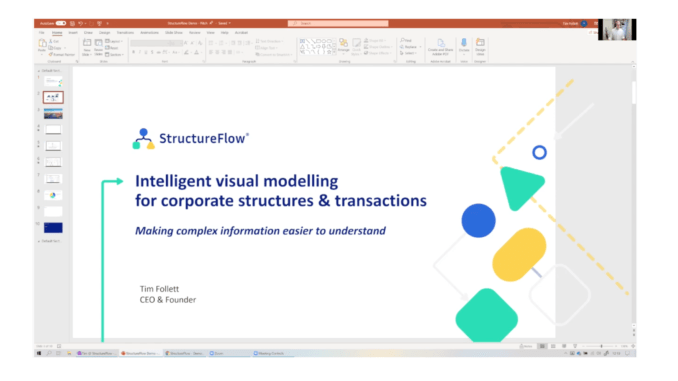
StructureFlow is different to many other legal tech companies. This is because it operates in a graphical world of visually representing how lawyers work. Perhaps the easiest way to explain StructureFlow is to say it helps lawyers create an interactive image of what a deal looks like, what is contained in that deal in terms of links to documents, and what stage the parties are at in the transaction.
In effect this shows a visualisation with three dimensions: entities and their relationships; graphical click-throughs to the underlying documents for each entity; and representations of where each stage of the deal has got to, e.g. if documents for one part of a transaction have been signed.
In fact, as Artificial Lawyer was talking to Founder, Tim Follett in this AL TV Product Walk Through, the possibilities of what this visual approach to legal work could do just kept on expanding. For example, you could use StructureFlow as something of a deal management tool, not just as a guide to what is in the deal.
It really is worth checking out the AL TV Product Walk Through below if you want to appreciate the value of making things visual, rather than just text. The Walk Through was meant to be about nine mins, but this approach is so interesting, we kept going a bit longer.
(Press play to watch inside the page. Approx 17 mins, but if you are in a rush the first section should give a useful intro to the tool.)
Follett was an associate at Slaughter and May, then Farrer & Co, before starting StructureFlow in late 2017. Now, after three years of hard work and growing the company StructureFlow has two offices, one in London and another in Singapore. In 2019 it was the winner of Slaughter and May’s Collaborate incubator project, and is also part of Allen & Overy’s FUSE technology cohort.
When he was a lawyer, Follett worked mostly on transactions, often on private equity deals where there were multiple parties and a high level of complexity. He explained to Artificial Lawyer how he had always had a very visual way of conceptualising a deal and had got into the habit of creating diagrams to explain what was going on, (see a pre-StructureFlow example below).
But, doing this by hand was challenging, moreover it was a static image, and certainly not digitally interactive.

The diagrams he made allowed him to ‘cut through complexity‘ and really show to all the parties in a deal what was actually taking place. Hence the value of StructureFlow, which brings to life those early static diagrams and makes them an integral part of the deal process – and which can be shared with all involved.
The approach overlaps with several fields, including no-code automation, although this system is not seeking to automate the deal process – rather it is showing what’s happening; and it also connects to the field of legal design whereby legal meaning is represented more clearly than traditional approaches to text, and often uses graphical elements.
Overall then a very interesting system that had this site wanting to spend more time exploring it. It certainly feels as though graphical representation of legal work – not just transactions – is an area full of possibilities.
1 Trackback / Pingback
Comments are closed.